Due to the COVID-19 pandemic, American businesses are facing an unprecedented time. Whether your business is closed temporarily, or you are functioning with bare bones staff and services, you may find you have some extra time on your hands (or staff that does). Now is the time to consider important housekeeping items you may not have time for once business picks up again, such as ensuring your facility is equipped with appropriate, ADA compliant signage.
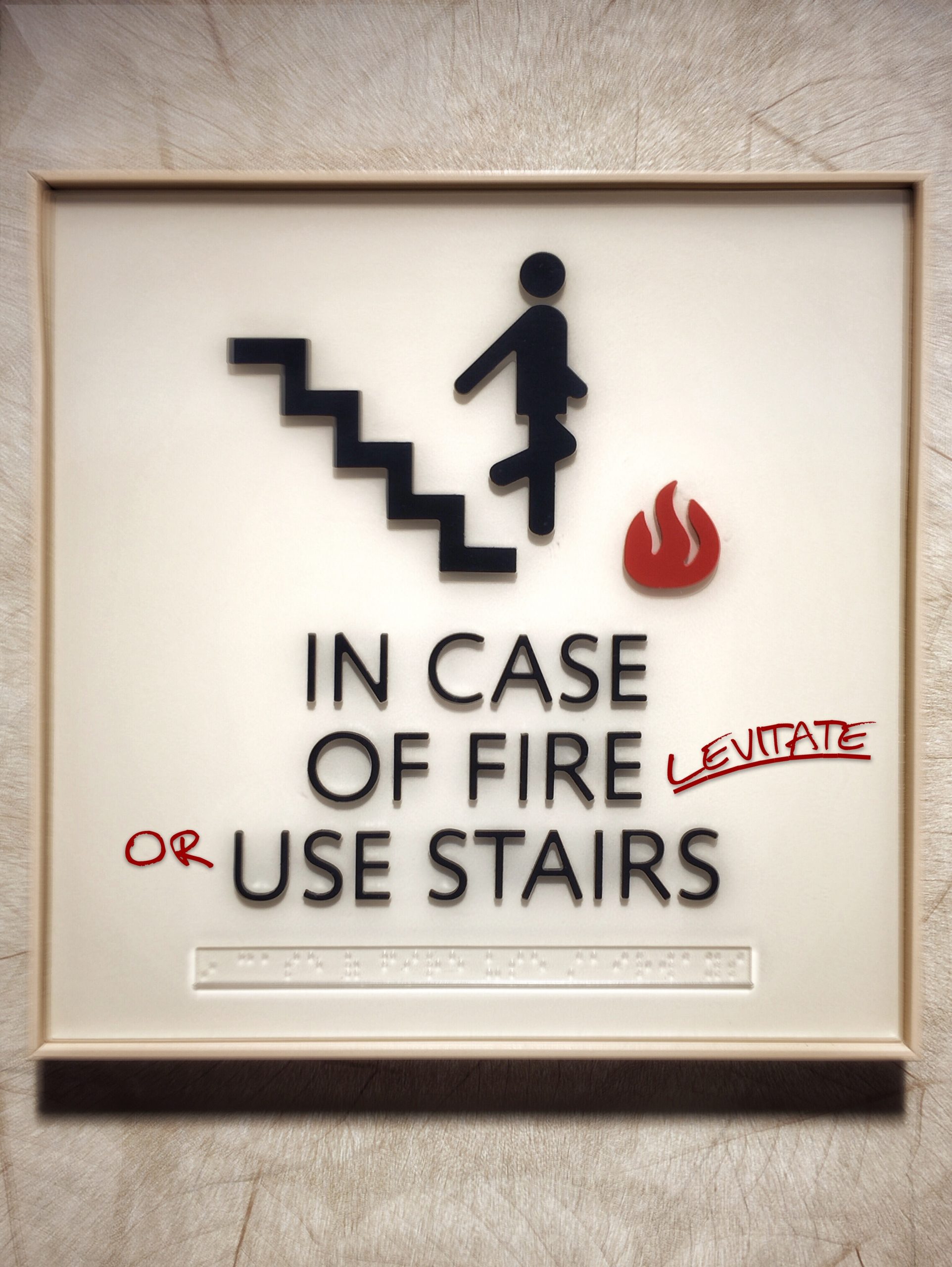
ADA compliance is an important topic for every commercial property manager. Not only is it essential to keep up with the latest ADA standards, ADA compliant signage can be helpful in growing your business. Taking time to understand ADA requirements and working hard to implement those standards within your business show that you are committed to improving access for all customers. ADA signs in your building and on your property benefit millions of people who are legally blind, while also helping our aging population of senior citizens maintain their independence.
Unfortunately, understanding and interpreting government regulations and standards can sometimes be tricky. That’s why we’ve put together this quick resource guide for ADA compliant signage.
With excerpts and contributions by Marcela Abadi Rhoads, Owner of Abadi Accessibility and author of The ADA Companion Guide
A Quick History Lesson
In 2019, The Department of Justice published revised regulations for Titles II and III of the Americans with Disabilities Act of 1990. These regulations were then revised with enforceable accessibility standards in the “2010 ADA Standards for Accessible Design.” This act covers a variety of disabilities, including visual impairment and mobility. It also provides information to mobility-impaired patrons who need to know where their accommodations can be found.
What Signs Must be ADA Compliant?
Signs are not required, but if signs are provided, they must meet specific requirements and specifications related to character proportions, height, pictorials and braille height and location. These requirements can be found in Section 4.30 of the ADAAG.
Some signs are not required to be ADA compliant. These include:
- Building addresses
- Directories
- Parking signs
- Menus
Temporary signs, such as for a room that could change in function (i.e. a classroom that sometimes serves as a science lab but may also be used for history classes) are also not required to be ADA compliant.
The ADA and TAS (Texas Accessibility Standards) state that “signs which designate permanent rooms and spaces” must comply with ADA guidelines. It is up to the building owner and designer, however, to determine the definition of a “permanent” room or space. Restrooms are one example of rooms that should be considered permanent.
In determining a room’s permanence, consider how likely it is that the function of the room will change. If it is not likely to change, ADA compliant signage is required in identifying that room.
What are the ADA Regulations for Signage?
1. Raised Characters and Braille
Letters and numerals should be raised 1/32 in, uppercase, SANS SERIF or SIMPLE SERIF type and are to be accompanied by Grade 2 Braille. Raised characters should be at least 5/8 in (16 mm) high, but no higher than 2 in (50 mm).
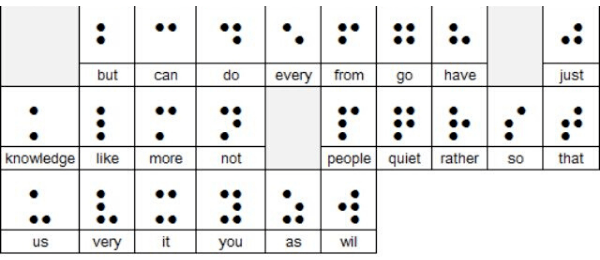
2. Pictograms
Pictograms (if provided) should be accompanied by the equivalent verbal description placed directly below the pictogram. Pictograms are figures that depict what the words are stating. The border dimension of the pictogram should be 6 in (152 mm) minimum in height. (This doesn’t mean that the pictogram has to be 6″ high, but everything must fit on a minimum 6″ border.)
3. Finish and Contrast
The characters and background of signs should be eggshell, matte, or other non-glare finish. The characters and symbols should contrast with their background – either light characters on a dark background or dark characters on a light background.
4. Mounting Location
Signage is to be located adjacent to the latch side of the door (including double-leaf doors), and not on the door itself. Visually impaired individuals are instructed to locate the door handle, then to look for a sign on the wall adjacent to it. If the sign is placed on the door, or on the wrong side of the door, the person is at risk of being hit by an opening door, or of missing the sign altogether.
5. Mounting Height
Mounting height is to be 60 inches (1525 mm) above the finish floor to the centerline of the sign. Mounting location for such signage should be placed so that a person may approach within 3 inches (76 mm) of signage without encountering protruding objects or standing within the swing of a door. See figure 43 (e) below.
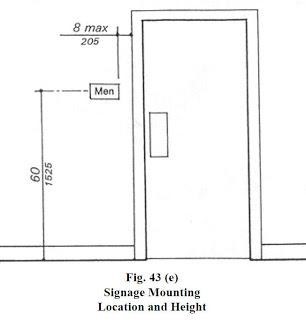
6. Directional Signs
Signs providing directions to functional spaces of a building are also required to comply with parts of the guidelines. For example, if not all entrances to a building are accessible, a directional sign with the accessibility symbol is required to let patrons know where to find the accessible entrance. Directional signage should be placed in a location that does not require a person to retrace the approach route from the inaccessible entrance.
Non-accessible restrooms should have a directional sign pointing the individual to the accessible restroom. The same goes for non-accessible telephones. These signs must also have the accessibility symbol on them.
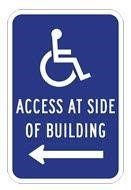
7. Informational Signs
Information signage might be used at assembly areas to inform patrons of the availability of accessible seating and of provided assisted listening devices. These signs would be placed at the ticket counter.
Informational signs must have the proper character proportion and width-to-height ratio and minimal size lettering. They do not have the same requirements as building signage, but they should have the proper proportion, finish, and contrast.
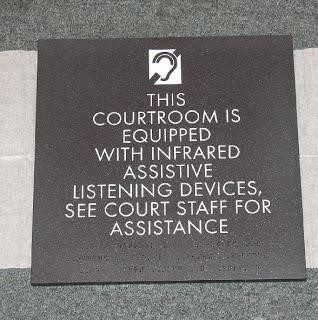
Need More Information?
FSGS has a team of specialists who can help you design, print, and mount your signage based on the latest ADA guidelines. Contact us to find out how we can help you and your property remain compliant.
For information about the ADA, including the revised 2010 ADA regulations, please visit the department’s website. For an ADA inspection, you can contact Ms. Rhoads at (214) 403-8714.
Keep Reading
Seamless Custom Signage Solutions: What A Dedicated Partner Can Do For You
Weaving Signage Strategy Into Your Master Planning
Red Elephant (AIM & N Graphic Solutions) Ranks No. 1779 on the 2023 Inc. 5000 List
The Ultimate Buyers Guide
Complete the form below for a free guide you can use to prepare before our meeting.

